THE DONDORF FORTUNE TELLING CARDS &
VARIATIONS
-5-
Thus far a comparison has been made between the original
Dondorf and the Carreras cards, but by introducing some Lenormand cards by other
manufacturers for comparison, a last point can be made. From our collection
we've chosen a German deck by the Vereinigte Stralsunder Spielkartenfabriken from
around 1895, a Belgian deck by Etablissements Brépols from around 1910, an
Austrian deck by Ferdinand Piatnik & Sohne from Vienna, probably from the
1940's, and a deck by the German VASS from 1950.
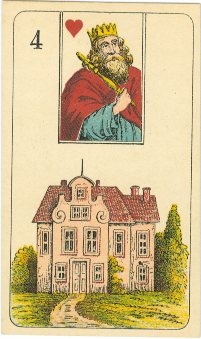 |
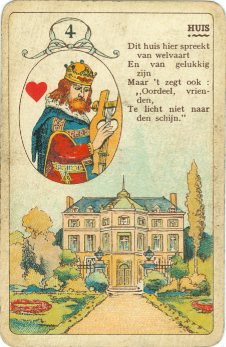
|
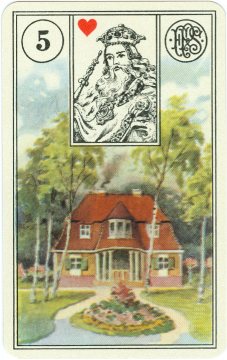
|
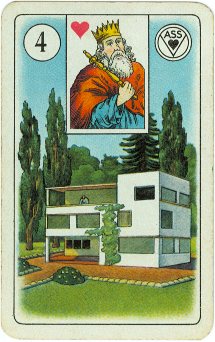
|
| Ver. Stralsunder Spielkarten ca. 1895 |
Ets. Brépols ca. 1910 |
Ferdinand Piatnik & Sohne 1940's
(?) |
VASS, 1950. |
|
|
|
|
|
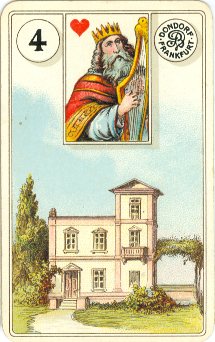
|
We have chosen cards #4 and
#13 to illustrate that the
Lenormand rules gave each manufacturer a relatively free choice of design.
Of course each scene was described, but within that description each
manufacturer could depict their images in their own way.
We have chosen card # 4, because a house is an object that easily
leaves room for interpretation and as we can see each manufacturer has
used that. And of course time has influenced the architectural design of
the house too. The same can be said about children and their toys, as illustrated
on the cards #13.
A few remarks
about the shown cards: all cards have the same card
value, either King of hearts or Jack of Spades, and the same topic of
design, but the numbers, 4 or 13, are used in all decks, except the
Piatnik one.
Another remarkable feature is that the VASS edition has used
the basic design of the small playing cards by the Vereinigte Stralsunder
Spielkartenfabrik and not the Dondorf designs, although it was published
after the VASS had taken over the Dondorf company in 1933. It's not shown
here, but the back design of the VASS edition is the same as used on the
Dondorf #4 variation. |
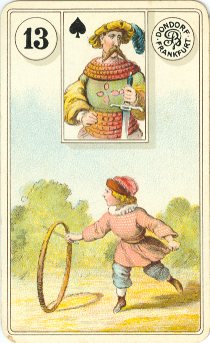
|
|
|
|
|
 |
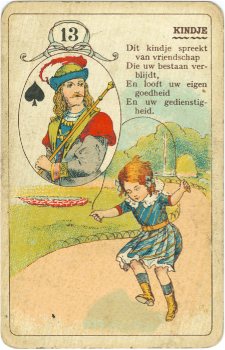
|
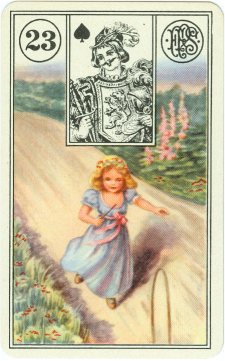
|
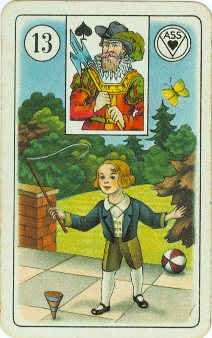
|
In all the mentioned decks the design of each card is
different from the others. With this comparison between different manufacturers the high
similarity in design of the Dondorf and Carreras decks gets an extra meaning. In
the 1920's copyrights were well established and respected within western Europe.
So it's very unlikely that the Carreras decks were a rogue edition. Carreras was
a well-known and respected company and it's doubtful that they would engage in a
rogue edition that was distributed in large numbers with their tobacco products.
Because of the number of decks involved, it's likely that the printing was done
by a major manufacturer. It's still possible that the Carreras decks were
produced under license by another -maybe English- manufacturer, but in the late 1920's almost all major manufacturers used the new offset
printing technique for their new decks. Only the Dondorf company continued to
use chromolithographic printing for their new decks until it was taken over by
the VASS in 1933. Together with the several other features in the
design that we have shown, we have come to the conclusion that it's almost
certain that the Carreras edition was produced by the Dondorf company too.
In our latest addition to the Braun catalogue on Dondorf,
which dates from 1996, Franz Braun mentions the existence of the Carreras decks,
but can't find any documents that link it to the Dondorf company. Recently we
asked some other collectors if this matter had been resolved yet and their
negative answer has lead to this article. Of course we hope that some day a
document will turn up that will resolve the question, but until then we hope
that this article will be a positive contribution to the discussion.
-1- -2-
-3- -4-
-5-
VARIATIONS









